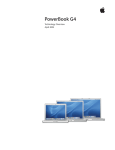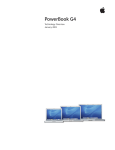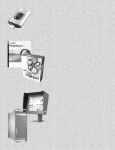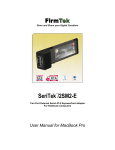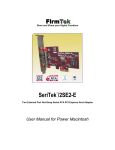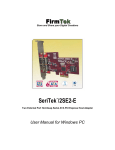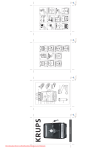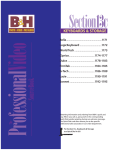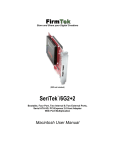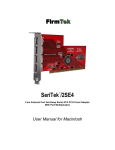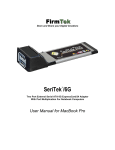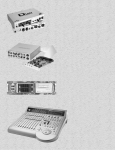Download Apple M9677LL - PowerBook G4 User manual
Transcript
Store and Share your Digital Creations SeriTek /1SM2 ™ Two Port External Serial ATA CardBus Adapter For Notebook Computers User Manual for Power Macintosh FirmTek, LLC www.firmtek.com Copyright Copyright © 1998-2006 FirmTek, LLC. All rights reserved. No part of this manual may be reproduced, translated by any means, photocopied, or transmitted in any form without the prior written permission of FirmTek. Trademarks FirmTek, UltraTek, AV-Tek, SeriTek names and logotypes are trademarks of FirmTek, LLC. Apple, Macintosh, Power Macintosh, PowerBook, Mac OS 9.XX, Mac OS X, and the Mac logo are registered trademarks of Apple Computer, Incorporated. The "Built for OS X" graphic is a registered trademark of Apple Computer, Incorporated, and used under license. All other manufacturer product names mentioned in this manual are for identification purposes only and are trademarks or registered trademarks of their respective owners. Changes FirmTek reserves the right to make any changes to product design, specifications, or details without notice. Actual product photos or screenshots may look different from those provided. Notice The material content of this manual is for informational purposes only. It is possible the content of this manual may contain technical inaccuracies, typographical, or other errors. FirmTek assumes no liability for any errors, omissions, or from the use of this manual that may result from such errors, including, but not limited to loss of data or profits. Before installing SeriTek/1SM2 or any other hardware or software, you are responsible for backing up data contained on any storage devices. After hardware or software installation, you are responsible for backing up data on any storage devices at frequent intervals. FirmTek, LLC is not liable for any loss of data or damage to equipment resulting from the use of SeriTek/1SM2. External Shielded Serial ATA Cables The SeriTek family of external Serial ATA adapters (SeriTek/1SE2, SeriTek/1eSE2, SeriTek/1VE2+2, SeriTek/1VE4, SeriTek/1eVE4, SeriTek/1SM2, and SeriTek/2SM2-E) use specially shielded external Serial ATA cables to ensure integrity during data transfers. Use caution and handle the cables carefully. Hold the connector at the ends (not the cable) When inserting and removing the cable. Note: The SeriTek/1eSE2, SeriTek/1eVE4, SeriTek/1SM2, and SeriTek/2SM2-E support the newer style Serial ATA connectors, called “ eSATA”connectors. These connectors provide improved reliability with special metal shielding and retention springs for positive locking. See “ Connecting the Shielded Data Cables”section of this document for more details. TABLE OF CONTENTS I. Introduction.. ............................................................................................ 1 II. SeriTek/1SM2 System Requirements ..................................................... 4 III. Installing the SeriTek/1SM2..................................................................... 5 IV. Connecting and Formatting Hard Drives................................................. 8 V. Using SeriTek/1SM2 Hot-Swap Functionality ....................................... 20 VI. Troubleshooting ..................................................................................... 24 VII. Product Support..................................................................................... 26 VIII.Product Warranty and Disclaimers........................................................ 26 IX. Regulatory Compliance Statements...................................................... 27 I. Introduction Welcome Congratulations and thank you for purchasing the SeriTek/1SM2 Serial ATA CardBus host adapter. This product is yet another innovative solution from the innovative folks at FirmTek. About This User Manual This User Manual was written with the assumption you are familiar with your PowerBook computer, and are comfortable with inserting devices into its CardBus slot. For further information, and to get acquainted with your computer, please refer to your PowerBook User Manual. About Serial ATA Technology An evolutionary replacement for Parallel ATA, Serial ATA (Advanced Technology Architecture) is an interface that allows you to add hard drives and peripherals to your Macintosh. Serial ATA offers insulated cables that are thinner and longer with small 7-pin connectors that allow you to reliability add fast external storage to your PowerBook computer which you cannot do with the previous Parallel ATA technology. About the SeriTek/1SM2 Serial ATA CardBus Host Adapter The SeriTek/1SM2 CardBus adapter provides an easy and affordable way for Macintosh users to add inexpensive high-speed storage to their PowerBook computer. With two external Serial ATA ports, each offering 1.5Gbits/sec performance, the SeriTek/1SM2 provides the high bandwidth to meet the needs of performance-hungry applications. The SeriTek/1SM2 is CardBus compatible and should be used in systems that offer CardBus Compatible slots. Note: The SeriTek/1SM2 is not compatible with PC Card slots with PCMCIA 16-bit interface technology in early Macintosh notebooks. The SeriTek/1SM2 requires the newer 32-bit CardBus interface. A list of tested PowerBook computers is provided in Section II below, “ SeriTek/1SM2 System Requirements.”Please check your PowerBook specifications to determine if it offers 32bit CardBus interface support. About CardBus Technology CardBus 32 is a small form factor external expansion bus based on the standard PCI interface bus and used by many notebook and some desktop computers today. CardBus 32 offers 32 bits of address and data support and 33MHz busmaster operation. It is an enhancement to the original PCMCIA 16-bit interface technology used in early notebook computers. Package Contents One SeriTek/1SM2 CardBus adapter board User’ s manual on CD-ROM -1- SeriTek/1SM2 Two eSATA external ports with exclusive hot-swap capability Plug-and-Play ease of use Boosts overall system performance with per-port data transfer rates of up to 150MBytes/sec or 1.5Gbits/sec Supports PowerBook CardBus 32 interface Supports Mac OS 9 with limited functionality. Mac OS X version 10.3 or later is recommended Provides performance and protection: Supports native Mac OS X RAID 0/1; Mac OS 9 RAID with 3rd party software 48-bit LBA support for drive sizes larger than 137GB Perfect for upgrading and expanding PowerBook computers Bus master operation enhances multitasking during disk transfers and increases CPU efficiency: The CPU is free to handle other tasks during data transfers between the PCI Bus and system memory Data protection: Supports Mac OS X RAID, Mac OS 9 Software RAID (third party software), and other storage utilities Reduced setting on storage devices (no master/slave) means easier installation and replacement Brings High Performance data storage to your PowerBook. Advanced applications that would normally require a Power Macintosh can now be run on your PowerBook: Desktop publishing, Audio/Video storage and editing, photo/graphics storage and editing, serving files, etc. -2- SeriTek/1SM2 Specifications General System Hardware Requirements PowerBook, or Power Macintosh with available 32bit CardBus expansion slot Operating Systems Supported Limited Mac OS 9.xx support: File Transfer only Mac OS X version 10.3 or later Bus Type 32-bit CardBus External Connectors 2-port external Serial ATA (SATA) shielded interface eSATA connectors Drive Types Supported Serial ATA hard drive Data Transfer Rates Up to 150 MBytes/second or 1.5Gbits/second burst data transfer rate Drive Modes Supported Serial ATA Advanced Data Features Fully compliant with Serial ATA 2.5 specification Bus Mastering off-loads data I/O handling from CPU Complete 32-bit CRC error checking, for all bits transmitted (command, data, and status), offers enhanced data protection for high-speed Serial ATA drives Two independent data channels allows for separate device timings Automatically identifies and configures drive types Cables Supported 7-pin external Serial ATA shielded cables/eSATA Warranty One year limited parts and labor Physical Dimensions CardBus Compliant Power Requirements 5V ± 5% Environmental Temperature: Operating: +5°C to +55°C Non-Operating: -25°C to +70°C Relative humidity: Operating: 20% to 80% Non-Operating: 15% to 90% EMC Compliance EN55022/1998, EN55024/1998 (European Community) FCC Part 15 Class B (US) -3- II. SeriTek/1SM2 System Requirements Operating System Mac OS X version 10.3 or later Mac OS 9.XX drivers are included but support is limited to transferring data from a Mac OS 9.XX system to a Mac OS 10.3 or later system. Hardware Requirements Compatible PowerBook notebook computers with available 32-bit CardBus expansion slot. See the PowerBook compatibility list below for a list of PowerBooks that have been tested for compatibility with the SeriTek/1SM2 adapter. External powered enclosure equipped with Serial ATA hard drive(s) or Parallel ATA hard drive(s). Parallel ATA hard drives require compatible Serial ATA to Parallel ATA converters contained within the enclosure. The SeriTek/1SM2 requires a PowerBook with at least one available 32-bit CardBus slot. PowerBook Compatibility List As of this writing, the following list of Apple PowerBooks notebook computers have been tested to work with the SeriTek/1SM2 adapter. Other PowerBook computers with CardBus 32-bit PC Card slots not specifically listed are expected to work with the SeriTek/1SM2 adapter. Please check your PowerBook specifications to ensure it offers CardBus 32-bit PC Card support. o Titanium G4 400MHz and 500MHz: Product code M7952LL/A, M7710LL/A o Titanium G4 550MHz: DVD reader product code M8362LL/A and with DVD/CDwriter product code M8622LL/A o Titanium G4 667MHz: Product code: M8363LL/A (DVD-ROM), M8623LL/A (Combo) o Titanium G4 667 and 800MHz: DVI product code M8591LL/A (667 MHz), M8592LL/A (800 MHz) o Titanium G4 867MHz and 1GHz: Product code M8858LL/A (867 MHz), M8859LL/A (1.00 GHz) o 15" Aluminum G4 1GHz and 1.25GHz: Product code M8980LL/A (1.00 GHz), M8981LL/A (1.25 GHz) o 15" Aluminum G4 1.33GHz and 1.5GHz: Product code M9421LL/A (1.33GHz), M9422LL/A (800 MHz) o 15" Aluminum G4 1.5GHz and 1.67GHz: Product code M9676LL/A (1.5 GHz, Combo), M9677LL/A (1.67 GHz SuperDrive) o 15" Aluminum G4 1.67GHz with HR screen: Product code M9969LL/A o 17" Aluminum G4 1GHz: Product code M8793LL/A o 17" Aluminum G4 1.33GHz: Product code M9110LL/A o 17" Aluminum G4 1.5GHz: Product code M9462LL/A o 17" Aluminum G4 1.67GHz: Product code M9689LL/A o 17" Aluminum G4 1.67GHz with HR screen: Product code M9970LL/A o PowerBook G3 "Pismo:" Family member M7572 -4- III. Installing the SeriTek/1SM2 Introduction This section describes the proper method of installing your SeriTek/1SM2. Caution: Please make sure your data is backed up prior to installing the SeriTek/1SM2 CardBus adapter and hard drive(s) or peripheral(s). The SeriTek/1SM2 CardBus adapter and your Macintosh contain sensitive components that can be permanently damaged by Static Electric Discharge. To minimize the chance of Electro-Static Discharge avoid touching the CardBus connector, handle only the edges of the card (do not touch the interface connector) and work in an area free of static electricity. Note: Prior to using you SeriTek/1SM2 disable Sleep Mode by adjusting the Energy Saver to never allow the sleep function on the system when the SeriTek/1SM2 is installed, if you need to sleep the system first un-mount drives attached to the SeriTek/1SM2 and unplug the adapter. Figure 1: Disabling Sleep Mode When Using the SeriTek/1SM2 -5- SeriTek/1SM2 CardBus adapter Installation on systems running Mac OS X 10.3 or later 1. Before inserting the SeriTek/1SM2 into your PowerBook computer, install the appropriate driver that is located on your SeriTek/1SM2 CD by installing the drivers on the CD. 2. The CD contains two installer applications, one for systems running Mac OS X 10.4.0 or later, and another for systems running Mac OS X versions prior to 10.4.0. Insert the CD and click on the appropriate “ installer application”for your particular operating system. 3. Insert the SeriTek/1SM2 adapter into an available CardBus slot (see Figure 2). Be sure the card fully seats. If the metal part of the card is not fully inserted, try turning the card over and insert again. Figure 2: Inserting the SeriTek/1SM2 4. Find the Icon that looks like a CardBus card; it should appear next to your other system status indicators. Figure 3: CardBus Icon 5. Click on the CardBus Icon ( ), you should see that the system identifies the card as a storage controller, the SeriTek/1SM2 (see Figure 4). In some circumstances the card may be identified as Unknown Vendor Mass Storage Controller. -6- Figure 4: SeriTek/1SM2 Being Identified by the System Note: If you inserted your SeriTek/1SM2 card into the system before installing the driver, the system will identify the card as being from an “ Unknown Vendor”(see Figure 5). This is not a reason for concern as the next time your storage is mounted the card will be properly identified as a SeriTek/1SM2. Figure 5: “ Unknown Vendor”Being Identified by the System 6. You are now ready to connect and initialize your storage; please see Section IV: “ Connecting and Formatting Hard Drives”section located below. SeriTek/1SM2 CardBus adapter Installation on Mac OS 9: 1. Drag and drop the system enabler from the CD to the active system folder. 2. Reboot your PowerBook. 3. Insert the SeriTek/1SM2 adapter. Ready for Use Your SeriTek/1SM2 CardBus adapter is now installed. You are now ready to connect and initialize your storage; please see Section IV: “ Connecting and Formatting Hard Drives” below. This section describes important differences in Serial ATA connectors. -7- IV. Connecting and Formatting Hard Drives Introduction This section describes how to connect external hard drive enclosures and a method of formatting your Serial ATA hard drive(s) using Apple’ s Disk Utility (Mac OS X). If you decide to use a third party drive setup utility, please refer to the documentation provided with the utility. Connecting the SeriTek/1SM2 to an External Enclosure 1. The SeriTek/1SM2 is compatible with a wide range of external enclosures. Enclosures must meet basic requirements which include: Adequate power and cooling to support the hard drives (dedicated power supply). 7-pin shielded receptacles compatible with FirmTek’ s shielded cables (original Ishaped or newer eSATA cables); see below. Support for Serial ATA Version 1.0 or Serial ATA Version 2.0 Serial ATA hard drives, or Parallel ATA hard drives with compatible Serial ATA to Parallel ATA converter 2. Install hard drives into the external enclosure according to the instructions included with the enclosure. 3. Attach one end of FirmTek’ s shielded Serial ATA cable(s) to the Serial ATA receptacle(s) on the SeriTek/1SM2 and connect the other end(s) to the external enclosure. 4. The external enclosure’ s may be powered on or off at this time. If it is off power it on at this time. Note: FirmTek Serial ATA cables were specially designed to be compatible with PC and Macintosh computers. Please use only FirmTek external shielded Serial ATA cables with the SeriTek/1SM2. The original Serial ATA connectors have an L-shaped opening, see Figure 6A. The newer eSATA connectors have a rectangular I-shaped opening, see Figure 6B The SeriTek/1SM2 uses the newer eSATA connectors, also known as I-shaped connectors, yet some drive enclosures require cables that utilize an L-shaped connector. For these types of enclosures, the cable required will have rectangular I-shaped eSATA connector, and one L-shaped SATA connector as shown below in Figure 6. Fig: 5A Figure 6A: Original L-shaped SATA connector FigureFig: 6B:5BNewer rectangular eSATA I-shaped connector Figure 6: Serial ATA Connector Types: Original L-shaped and newer eSATA I-shaped Note: If you are using your SeriTek/1SM2 with a disk drive enclosure that uses eSATA connectors then you will require SATA cables that have two rectangular I-shaped eSATA connectors, just like the two connectors shown below in Figure 7. -8- Figure 7: Using SeriTek/1SM2 with a drive enclosure that has I-shaped eSATA connectors; both cable connectors will be identical. Making the Serial ATA Connection Caution: Be sure to connect the cable using the proper orientation to your SeriTek host adapter and external enclosure. It should easily snap into place. Please do not force the cable connector onto the host adapter and hard drive or peripheral interface. Remember that connectors and receptacles must be of the same type for them to fit: L-shaped connector to L-shaped receptacle or eSATA connector to eSATA receptacle. First check that you are connecting the correct type of connectors and receptacles to each other. If your connectors still do not fit, rotate the cable and try again 4. Connect your drive cables, or insert them in an enclosure. If your enclosure is powered on, a configuration screen will appear. If your enclosure is powered off, power it on, and you should see the following configuration screen appear. Figure 8: Mac OS X Configuration Changed Screen Make sure that you make all changes to your storage configuration (inserting/removing drives) before closing this window! 5. After finalizing your new storage configuration click on Done, or Done –Show More Details: If you click “ Done” ,a“ Disk Insertion”window will appear on your desktop, see installation step 6 below. If you click “ Done –Show More Details”one of more message windows will be displayed sequentially detailing the new storage configuration details. -9- Figure 9: Examples of More Details Message Windows: (Mac OS X examples) 6. If the storage device(s) have not been formatted for use with the Macintosh, Disk Insertion message window will appear on your desktop for each un-configured storage device. Select Initialize to setup your storage or Ignore if you wish to configure these disks later (see Figure 10). Figure 10: Disk Insertion Window -10- Formatting Serial ATA Drives Using Mac OS X Version 10.3 or Later 1. Turn on your PowerBook computer. Note: in Mac OS X Drive Setup disks attached to the SeriTek/1SM2 will appear as CardBus devices (in Mac OS 9 they appear as disks). 2. Open Apple’ s Disk Utility which is located in the Utilities folder of the Mac OS X start-up volume. To open this application: a) Double click the Mac OS X startup volume b) Double click the Applications folder c) Double click the Utilities folder d) Double click the Disk Utility icon (See Figures 11 and 12 for examples) Figure 11: Locating Apple’ s Disk Utility Figure 12: Alternate Method for Locating Apple’ s Disk Utility -11- 3. Review the list of hard drives show within Disk Utility (see Figure 13). Drives currently in use should have a list of volume names below it. New, unformatted drives typically have no volume names listed. Carefully select the drive you wish to format. Note: Some versions of Apple Disk Utility incorrectly display Serial ATA hard drives as having the Connection Type of “ Slave.”Serial ATA hard drives are all in fact “ Master”drives. Later versions of Apple Disk Utility correctly display Serial ATA hard drives as “ Master.”If your Serial ATA hard disk is listed as “ Slave,”don’ t worry, its performance will not be affected. Figure 13: Example Hard Drive Listing -12- 4. After carefully selecting the hard drive you wish to format, select the Erase tab in Apple’ s Disk Utility (see Figure 14). Figure 14: Selecting the Erase tab in Apple’ s Disk Utility 5. For Volume Format, the most common choice is “ Mac OS Extended.” 6. In the Name field, you may type a name of description for your new hard drive. 7. Note: FirmTek Mac OS 9 support is limited to simple file transfer: FirmTek recommends that Mac OS 9 users use the FirmTek/1SM2 only to transfer files. If you wish to have your new hard drive be recognized by Mac OS 9.XX, select the Install Mac OS 9 Drivers checkbox. 8. Be sure to back up any data on the hard drive before clicking the Erase button to format the hard drive. 9. Once the hard drive is initialized, it will be depicted as an icon on your Mac OS X desktop. -13- Creating a RAID Volume with Serial ATA Hard Drives Using Mac OS X version 10.3 or Later The Mac OS X 10.3 or later RAID (Redundant Array of Inexpensive Disks) capability allows you to increase volume sizes, provide data redundancy in case of a hard drive failure, or increase performance by allowing you to join multiple drives into a single volume. Two RAID types are supported, Stripe and Mirror. A volume that is striped (also known as RAID 0) has its data broken up and spread across multiple hard drives. Read/write performance, especially for sequential access, is improved when the data is read and written across multiple drives simultaneously. No data integrity is provided with striping however, and since data is spread across multiple drives, if one of the hard drives fails, all of the volume’ s data will be lost. A volume that is mirrored (also known as RAID 1) has its data duplicated from one hard drive onto another. A mirrored volume offers data integrity and immediate access to data in the event of a single hard drive failure. Because data is mirrored (duplicated) across two hard drives, only half of the combined capacity of the two drives is available. 1. Turn on your PowerBook computer. 2. Open Apple’ s Disk Utility which is located in the Utilities folder of the Mac OS X start-up volume. To open this application: a) Double click the Mac OS X startup volume b) Double click the Applications folder c) Double click the Utilities folder d) Double click the Disk Utility icon (See Figures 11 and 12 for examples) 3. Review the list of hard drives show within Disk Utility (see Figure 13). Drives currently in use should have a list of volume names below it. New, unformatted drives typically have no volume names listed. -14- 4. Select the RAID tab in Apple’ s Disk Utility (see Figure 15). Figure 15: Selecting the RAID tab in Apple’ s Disk Utility 5. Carefully select and drag a hard drive to add as a member of the new RAID volume onto the Disk status window. 6. Repeat step 5 for each member for the RAID volume. 7. Choose a RAID Scheme: Stripe or Mirror. 8. Name the new RAID volume. -15- 9. For Volume Format, the most common choice is “ Mac OS Extended”(See Figure 16). Figure 16: Example drives and options for a RAID volume -16- Note: For Mac OS X 10.4.0 and later you can select the RAID block size, for best performance select a RAID block size of 64K Figure 17: Selecting a RAID Block Size -17- After reviewing the options you selected, click on the Create button to initialize the new RAID volume (see Figure 18). Figure 18: Creating a new RAID volume -18- 10. After the RAID volume is successfully initialized, it should appear on the desktop. Figure 19: RAID set configured -19- V. Using SeriTek/1SM2 Hot-Swap Functionality Introduction The SeriTek/1SM2 provides advanced hot-swap functionality which provides flexibility similar to that of Universal Serial Bus (USB) and FireWire without the burden of having to power down your system when adding or removing hard drives. Using a unique patent-pending method, SeriTek/1SM2 support RAID hot-swap disks under both Mac OS 9 and Mac OS X. Hot-Swap Guidelines Do not disconnect or remove hard drives while transferring data. Save your work and close associated applications before removing the external hard drive (applications need to be closed since they may keep temporary working files open on the external hard drive). Always unmount the volumes (eject or drag the volumes to trash) associated with an external hard drive before removing it. As a general rule, power down the external hard drives after powering down the PowerBook computer. Power on the external enclosure before powering on the PowerBook computer. The SeriTek/1SM2 hot-swap functionality is designed to provide RAID-based volume spanning among two hard drives, to one SeriTek/1SM2 host adapter. Future SeriTek/1SM2 firmware may provide the ability to support RAID volumes that span hard drives among multiple SeriTek/1SM2 host adapters If RAID volumes span internal and external hard drives, do not attempt to remove and insert external hard drives that partially support the RAID volume or data loss may occur. Do Not Remove the SeriTek/1SM2 from its CardBus slot without dismounting the drives and powering off the SeriTek/1SM2 first, see the Hot-Swap Procedure section below. Hot-Swap Procedure The hot-swap procedure is the same for both Mac OS 9.XX and Mac OS X Version 10.3 and later. The example dialog boxes below are from Mac OS X. Mac OS 9.XX dialog boxes are similar. Connecting External Hard Drive(s) If your PowerBook computer is not yet powered on, power on the external enclosure then power on the computer. If the PowerBook computer is already powered on, you may connect the external hard drive(s). When you connect the first hard drive, you will see a “ SATA Configuration Changed”window (See Figure 20). If this is the only hard drive you connect, you may select “ OK”in the dialog box. If you have an additional hard drive to connect, connect it and then select “ OK”in the dialog box. Figure 20: Connecting External Hard Drive(s) -20- Verifying Hard Drive Connections Once you have connected the external hard drive(s) a dialog box will appear which verifies how many devices were added to the system (See Figure 21). There are Two Serial ATA channels on the SeriTek/1SM2: 0, 1. One or more dialog boxes will appear verifying which drive was attached to which channel (See Figure 22). Figure 21: Connecting devices to the SeriTek/1SM2 Figure 22: Example Serial ATA hard drive connected to channel 0 Removing External Hard Drive(s) Caution: To prevent loss of data, save your work and close associated applications before removing the external hard drive (applications need to be closed since they may keep temporary working files open on the external hard drive). Always unmount the volumes (eject or drag the volumes to trash) associated with an external hard drive before removing it. Eject or drag all of the volumes associated with the hard drive(s) before disconnecting or removing them. When removing a hard drive you will see a “ SATA Configuration Changed” window (See Figure 23). If this is the only hard drive you remove, you may select “ Done”in the dialog box. If you have an additional hard drive to remove, remove it and then select “ Done”in the dialog box. -21- Figure 23: Removing External Hard Drive(s) One or more dialog boxes will appear verifying which drive was attached to which channel (See Figure 24). Figure 24: Example Serial ATA hard drive removed from channel 0 Improperly Removing External Hard Drive(s) Caution: To prevent loss of data, save your work and close associated applications before removing the external hard drive (applications need to be closed since they may keep temporary working files open on the external hard drive). Always unmount the volumes (eject or drag the volumes to trash) associated with an external hard drive before removing it. If you do not properly unmount volumes before removing the associated hard drive(s), a “ Device Removal”dialog box will appear (See Figure 25). This dialog box shows up as a reminder to unmount volumes properly before disconnecting or removing external hard drives. Failure to properly unmount volumes before disconnecting external hard drives may result in lost data. Figure 25: Improperly Removing External Hard Drive(s) -22- After unmounting your disks, click on the CardBus symbol and select Power off Card, see below: Figure 26: Powering Off Your SeriTek/1SM2 Connecting and Immediately Removing External Hard Drive(s) If you connect an external hard drive, then remove it without acknowledging it has been added to the system, a dialog box will appear that explains no new hard drive(s) were detected (See Figure 27). Figure 27: Connecting and Disconnecting an External Hard Drive(s) -23- VI. Troubleshooting The SeriTek/1SM2 adapter does not seem to be recognized Check the SeriTek/1SM2 adapter by ensuring it is properly seated in the CardBus slot in your computer. My hard drive or peripheral won’ t work Check cables and connections. Ensure the 7-pin Serial ATA cable is properly oriented to the connectors on the SeriTek/1SM2 host adapter and the external enclosure. Ensure the hard drives in the enclosure are properly powered. Apple System Profiler under Mac OS X 1. Open the Apple System Profiler by clicking opening the Finder, opening Applications, opening the Utilities folder, and double clicking on Apple System Profiler. 2. Select the Devices and Volumes tab (early Mac OS X version) or open Hardware and select PCI/AGP Cards (See Figure 28). Figure 28: SeriTek/1SM2 Listed Under PCI/AGP Cards 3. Under PCI/AGP Cards section, SeriTek/1SM2 should show up as an “ ata”card type. 4. If SeriTek/1SM2 is not listed, shut down your PowerBook computer and try re-seating it in the CardBus slot by removing and reinserting it. Repeat steps 1 through 3. If the SeriTek/1SM2 still doesn’ t show up in the Apple System Profiler, try moving it to another PCI slot. The transfer rate on my PowerBook G3 seems much less than the Serial ATA specified maximum of 150Mbytes/sec. Early “ PowerBook”computers, typically built before the G4 “ Titanium”PowerBook was available, have limited hardware resources. These limited resources severely limit data transfer rates of many storage technologies, including Serial ATA. -24- Does the SeriTek/1SM2 work with all PowerBook computers? No, the SeriTek/1SM2 requires a PowerBook with at least one 32-bit CardBus slot. PowerBooks made before the PowerBook 3400, iBooks, and PowerBooks with 12”screens do not have these slots. The SeriTek/1SM2 is optimized for use with G4 “ Titanium” PowerBooks or later models with 15”or 17”screens. Even though in most cases the SeriTek/1SM2 works well PowerBook models 3400 or later (these are black colored PowerBooks) functionality is NOT guaranteed. Also functionality is NOT guaranteed when running Macintosh OS 9; a MacOS-9 driver is included however, yet No further MacOS-9 enhancements are planned. My older Parallel ATA hard drives and peripherals have jumper settings. However I can’ t find jumper settings on my new Serial ATA hard drive or peripheral. How can I set it to Master or Slave; is there any way to set the SCSI ID? Serial ATA hard drives and peripherals are internally configured as Master drives. Only one drive can be attached to each Serial ATA bus/connector. There is no need to change settings on either the drive or the controller. I have an old Parallel ATA drive which I am trying to use with a Parallel ATA to Serial ATA converter, but it doesn’ t seem to work. Some older Parallel ATA drives do not comply with current ATA standards. Parallel ATA to Serial ATA converters cannot recognize such drives. -25- VII. Product Support Technical Support For additional information on how to use the SeriTek/1SM2, download the latest firmware updates, or for technical assistance, please visit us at www.firmtek.com, or email us at [email protected]. Please provide the following information when contacting us: Product model and serial number Driver version (You may use the Apple System Profiler as described in the troubleshooting section to determine the Driver version. Look for ROM# and Revision #) Macintosh model Macintosh OS type and version (example: Mac OS X, version 10.3) Hardware and software installed on your system Contact information including daytime telephone number and email address A detailed description of the question or problem Return Merchandise Authorization If FirmTek technical support determines the product needs to be repaired or replaced, a Return Merchandise Authorization (RMA) number and shipping address will be provided. Please pack in the original shipping container all of the original packaging - including the static bag, all hardware, software, cables, and other accessories that came with the original product. You are responsible for shipping and insurance costs, and any damage incurred due to improper packaging or transport. FirmTek reserves the right to determine whether the product is to be repaired or replaced with new or refurbished parts, or with a new or refurbished product. Standard United States return shipping charges will be paid by FirmTek. Foreign and other shipping methods such as express shipping are available for an additional charge. Write down the RMA number on the outside of the shipping container, and include the following information with the shipment: A description of the problem A copy of the original purchase invoice Return shipping address Contact information including daytime telephone number and email address FirmTek, LLC reserves the right to refuse shipments missing a valid RMA number. VIII. Product Warranty and Disclaimers FirmTek warrants to the original buyer only that this product shall be free from defects in material and workmanship for a period of 1 year from the original date of purchase. This warranty is valid only when the original purchase invoice is provided. This warranty shall not apply to any defects resulting from improper handling, misuse, misapplication, abuse, or unauthorized modification(s) which are performed by end user. FirmTek, LLC reserves the right to make changes to any products described in this manual at any time without notice. FirmTek, LLC assumes no responsibility for the use or reliability of hardware or software that is not supplied by FirmTek, LLC or its affiliated companies. FirmTek, LLC does not assume any responsibility or liability arising out of the application or use of any product described in this document, except as expressly agreed to in writing by FirmTek, LLC; nor does the purchase or use of a product from FirmTek, LLC convey a license under any patent rights, copyrights, trademark rights, or any other intellectual property rights of FirmTek, LLC or third parties. -26- IX. Regulatory Compliance Statements Federal Communications Commission Radio Frequency Interference Statement WARNING: Changes or modifications to this unit not expressly approved by the party responsible for compliance could void the user’ s authority to operate the equipment. This equipment has been tested and found to comply with the limits for a Class B digital device, pursuant to Part 15 of the FCC rules. These limits are designed to provide reasonable protection against harmful interference in a residential installation. This equipment generates, uses, and can radiate radio frequency energy, and if not installed and used in accordance with the instruction manual, may cause harmful interference to radio communications. However, there is no guarantee that interference will not occur in a particular installation. However, if this equipment does cause interference to radio or television equipment reception, which can be determined by turning the equipment off and on, the user is encouraged to try to correct the interference by one or more of the following measures: Reorient or relocate the receiving antenna. Increase the separation between equipment and receiver. Connect the equipment to an outlet on a circuit different from that to which the receiver is connected. Consult the dealer or an experienced radio/television technician for help. Use a shielded and properly grounded I/O cable and power cable to ensure compliance of this unit to the specified limits of the rules. This device complies with part 15 of the FCC rules. Operation is subject to the following two conditions: (1) this device may not cause harmful interference and (2) this device must accept any interference received, including interference that may cause undesired operation. CE European Union Compliance Statement EMC compliance: Emissions: EN55022: 1998, Class B Immunity: EN55024: 1998 EN61000-4-2: 1995+A1: 1998 EN61000-4-3: 1995+A1: 1998 EN61000-4-4: 1995 EN61000-4-6: 1996 EN61000-4-8: 1993 -27-






























